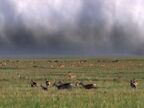May 7, 2018
I haven't been exposed to too many documentaries, but I only know that most of them are realistic and really record the content related to the theme.
After watching this time, I have two impressions:
On the one hand, I am very shocked, and I am moved by the richness, diversity, and life of this beautiful blue planet;
On the other hand, I am very worried that this beautiful planet is being destroyed by human beings. I don’t know how long those beautiful sights and magical creatures will exist.
I want to take screenshots everywhere in the film, and there are knowledge points everywhere. I saw many unheard of geographical names and landform features, learned about the wider world, and saw the true face of biodiversity; those ancient times, various All kinds of elves filled my eyeballs and entered my heart, I can only be amazed!
There are not many words to describe their strong vitality, their beautiful physique, and their unique perseverance and biological nature. I like every frame, every episode so much, I'm deeply addicted to it. The life-and-death struggle in the field, the migratory army in the grassland, and the army of "sand locusts" deeply stunned me...
Every time I recall all the scenes and clips I have seen, my heart will be filled with excitement and shock!
What follows are some impressive commentary snippets from the documentary:
·There are many magnificent but unknown beauties on the earth where we are located.
·The animals in the huge jungle, you can sing and I will come on stage, it may sound a bit noisy, but the ears of frogs can only hear the sounds of the same kind
Occasional sunlight brings life to the ground, old trees fall, and the thirst for sunlight sparks a competition. Hundreds of species wanting to compete for the top spot have many good starters and few good finishers. In less than four years, the gaps will be filled, and the steady hardwoods are the winners, replaced by the short-lived pioneers when they fall. A 50-meter tall tree like this can still bathe in sunlight for 200 years.
· Figs are an important food for chimpanzees, and some stars seem to be unable to eat enough. There are as many as 150 individuals in this group, the largest group found in Africa. Such a large group needs bigger territory and more fig trees, and they fight for figs... Shocking scene occurs, they grab an enemy baby orangutan and kill it Food. Killing competitors in the race is understandable, but we don't yet understand why they would eat the corpses of the same kind, perhaps just to eat a little more protein.
Teamwork brought great success to this group of chimpanzees, but they soon reached a power bottleneck, with competition for resources such that no single species could live in the jungle. The biodiversity of the rainforest is not easy to come by. It is the most balanced ecosystem in the world. The only thing that can be easily destroyed by another creature is humans, who are most closely related to chimpanzees.
Some people may think that climbing a big mountain means conquering the mountain, but we are all just passing by.
· Lake Baikal is the largest and oldest lake in the world. It is more than 600 kilometers long and more than 1,600 meters deep, and its water volume accounts for one-fifth of the total fresh water of all rivers and lakes on the earth. More than 80% of Baikal's species are unique.
The Swallow Cave in Mexico is the largest cave in the world and the last place on our planet to be involved in human exploration.
·Water is not only the invader of the cave, but also the builder.
View more about Planet Earth reviews










